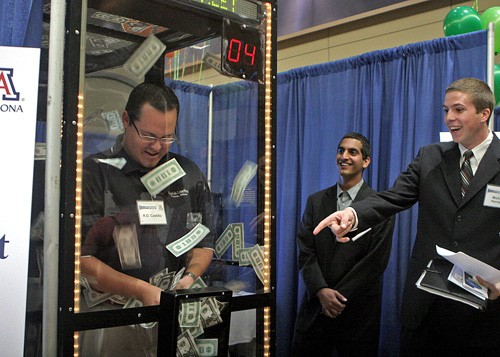Students, faculty and community members came together Tuesday to celebrate the seventh annual UA Innovation Day.
Innovation Day aims to celebrate the UA’s success in technology development by recognizing the research achievements of faculty, staff and students.
“”We want students to see that there is a practical side to the kinds of research one can do,”” said Leslie Tolbert, vice president for research, graduate studies and economic development. “”If that’s what appeals to students, it’s an avenue available to them.””
The day-long event included panel discussion, a Technology Innovation Awards Luncheon, an Innovation Showcase of students from the McGuire Entrepreneurship Program, displaying their business ideas, and new venture presentations among other activities.
“”Innovation Day has a great impact on the community because it ultimately results in high quality jobs and higher quality of life and wealth creation for the community,”” said Bruce Wright, associate vice president of University Research Parks.
Two Arizona Cancer Center researchers were honored with the 2010 Technology Innovation Awards.
Eugene W. Gerner, professor of cell biology and anatomy and co-founder of Cancer Prevention Pharmaceuticals, received a Technology Innovation Award. Gerner developed a two-drug combination, which has been shown to reduce the risk of recurrent colorectal polyps, a precursor to colon cancer, by up to 95 percent with minimal toxicity.
He aims to bring cancer prevention to medical practice.
“”It’s important that we address the problem, which is to treat the cancer risk factors,”” Gerner said. “”Today, there is no real cancer prevention that’s in clinical practice for any type of cancer, especially the major cancers.””
Samantha Kendrick, doctoral student in cancer biology, also received a Technology Innovation Award.
Kendrick worked in pharmacology and toxicology professor Laurence Hurley’s BIO5 lab. She did her dissertation project on chemo-sensitization by modulation of Bcl-2 expression.
“”We’re targeting Bcl-2 through DNA secondary structures,”” Kendrick said. “”There’s a lot of research being done on targeting Bcl-2 on the protein level, but we’re going one level above and trying to prevent expression of the gene from the very beginning.””
There were 93 students on 24 teams showcasing their business plans, according to Randy Accetta, a mentor in residents at the McGuire Center for Entrepreneurship.
Approximately 70 were undergraduate seniors.
“”When I was an undergraduate, I never thought of how to start a business and look ahead,”” Accetta said. “”Working with these students here, I see that they’re thinking of adding value to their communities by starting businesses. I think it’s brave for a 21-year-old for thinking about that.””
Petra Grubisic, a business senior, took part in showcasing the business plan for ValueXChange, a Web-based private lending market networking solutions for small-business borrowers who want financial assistance.
“”We’re talking to potential investors and customers and letting them know about our model,”” Grubisic said.
Rachel Kelly, a marketing senior, showcased her team’s business plan, FunFlights, a charter flight brokerage agency offering themed flights.
“”We’ve already investigated patents and drafted real papers, so if someone wanted to pick up our business plan, we would be ready for it to really happen,”” Kelly said.
Kelly and other student team members are all part of the Maguire Entrepreneurship Program.








